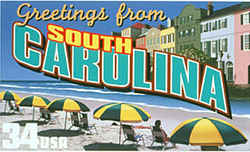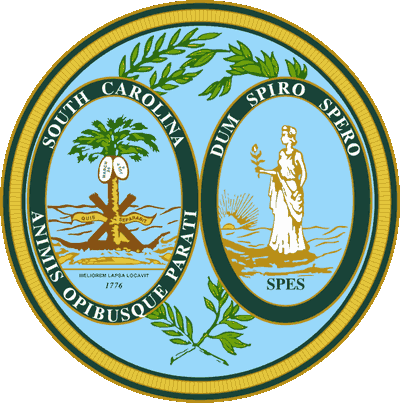

South Carolina Symbols
- » 50 States
- » Histories
- » State Symbols
- » Seals
South Carolina State Seal
Great Seal of the State of South Carolina

Adopted in 1776.
South Carolina's Great Seal was authorized by resolution of the General Assembly on April 2, 1776. The seal is made up of two distinct elliptical areas, linked by branches of the palmetto tree. The image on the left is dominated by a tall palmetto tree and another tree, fallen and broken. This scene represents the battle fought on June 28, 1776 between defenders of the unfinished fort on Sullivan's Island, and the British Fleet. The standing tree represents the victorious defenders, and the fallen tree is the British Fleet. Banded together on the palmetto with the motto "Quis Separabit?"("Who Will Separate?"), are 12 spears that represent the first 12 states of the Union. Surrounding the image, at the top, is "South Carolina,"and below, is "Animis Opibusque Parati,"or "Prepared in Mind and Resources."The other image on the seal depicts a woman walking along a shore that is littered with weapons. The woman, symbolizing Hope, grasps a branch of laurel as the sun rises behind her. Below her image is the word "Spes,"or "Hope,"and over the image is the motto "Dum Spiro Spero,"or "While I Breathe I Hope."
South Carolina Great Seal
On March 26, 1776, the Provincial Congress of South Carolina set up an independent government, electing John Rutledge, President. On April 2, 1776, the President and Privy Council were authorized by Resolution of the General Assembly "to design and cause to be made a Great Seal of South Carolina."
After the Declaration of Independence, a design for the arms of an official great seal, prepared by William Henry Drayton, a member of the Privy Council, was accepted, together with a design for the reverse, said to have been designed by Arthur Middleton. Both designs were turned over to an engraver in Charles Town and engraved as a great seal, which was used by Pres. Rutledge for the first time on May 22, 1777. The Seal was made in form of a circle, four inches in diameter, and four-tenths of an inch thick.
The current seal is made up of two elliptical areas, linked by branches of the palmetto tree. The left oval is the palmetto tree with a fallen oak at the base. The right oval is the goddess Spes (Hope) walking on the beach at dawn over discarded weapons. The State's two mottos surround the two ovals. On the left is "Animis Opibusque Parati", meaning Prepared in Mind and Resources. On the right, "Dum Spiro Spero", meaning While I Breathe I Hope.
Both the arms and reverse symbolize the battle fought on June 28, 1776, between the unnamed, and unfinished fort at Sullivan's Island (now Fort Moultrie), and the British Fleet.
This copy of one of the first seals of South Carolina appeared on March 28, 1785 in the nameplate of the State Gazette of South Carolina, a Charleston newspaper. The paper was published by Ann Timothy, the state's printer.
The Great Seal of South Carolina was "set" or "affixed" to the Ordinance of Secession of December 20, 1860, at Secession Hall in Charleston shortly after 7:00 p.m., following which convention delegates signed it, including Robert Barnwell Rhett, as some three thousand South Carolinians watched enthusiastically the proclamation of South Carolina as "a separate, independent nationality."
South Carolina Resolution of the General Assembly
South Carolina's Great Seal was authorized by resolution of the General Assembly on April 2, 1776.






